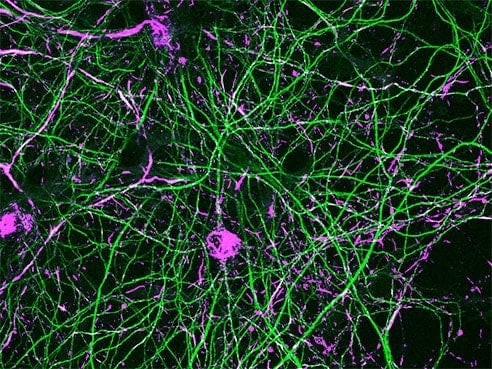They’re two of the biggest mysteries in Parkinson’s disease research—where does the disease start? And how can it be stopped early in the process?
Now, a new laboratory model of Parkinson’s is giving scientists an inside look at what happens in the brain years before motor symptoms appear. Specifically, it demonstrates how abnormal alpha-synuclein proteins, which are strongly associated with Parkinson’s, gradually spread from an area of the brain implicated in the early stages of the disease to other regions of the brain ultimately damaged by the disease. The findings were published today in the Journal of Experimental Medicine.
Parkinson’s is primarily a disease of aging, with most cases diagnosed after age 60. By the time symptoms appear, more than half of the brain cells that produce dopamine, a chemical messenger needed for voluntary movement, have died. What triggers this process is unknown, although evidence points to a combination of genetic, epigenetic and environmental factors. Strong evidence also suggests that clumps of abnormal alpha-synuclein play a role in the disease process. In recent years, scientists have found links to the early stages of Parkinson’s in other areas of the body, namely the gut and the nose.
“Better models that mimic the early stages of the disease will allow us to more precisely study Parkinson’s and, by extension, find new ways to potentially stop it before it progresses,” said Van Andel Research Institute researcher Nolwen L. Rey, Ph.D., the study’s first author. “We know that specific signs of Parkinson’s, including a loss of sense of smell, appear years before the onset of motor symptoms. Our new model replicates the phase that occurs long before diagnosis and, importantly, gives us a powerful tool to test novel interventions that might prevent the onset of Parkinson’s as we know it.”
The study demonstrates that alpha-synuclein travels along nerve cells in the olfactory bulb—the part of the brain that controls sense of smell—prior to the onset of motor symptoms and that this area may be particularly susceptible to the spread of alpha-synuclein, ultimately causing deficits in the sense of smell. Clumps of alpha-synuclein eventually reach several additional brain regions, including the brainstem area that houses dopamine cells.
“Perhaps most remarkably, we have created a model of prodromal Parkinson’s disease, the condition that precedes the diagnosis of the disorder in humans by five to 10 years, that successfully mimics the pattern of alpha-synuclein’s pathology in the brain,” said Patrik Brundin, M.D., Ph.D., senior author of the study and director of Van Andel Research Institute’s Center for Neurodegenerative Science. “Not only might this teach us something about how the disease develops and the importance of the olfactory system, but the model will also prove invaluable when testing novel therapeutics designed to slow down or stop the progression of disease.”
This work was supported by Van Andel Research Institute, the Peter C. and Emajean Cook Foundation, the European Research Council and University of Pennsylvania Morris K. Udall Parkinson’s Disease Research Center of Excellence. Other study authors include Jennifer A. Steiner (Van Andel Research Institute), Nazia Maroof (Roche Innovation Center), Kelvin C. Luk (University of Pennsylvania), Zachary Madaj (Van Andel Research Institute), John Q. Trojanowski (University of Pennsylvania), and Virginia M-Y Lee (University of Pennsylvania).
Rey NL, Steiner JA, Maroof N, Luk KC, Madaj Z, Trojanowski JQ, Lee VMY, Brundin P. In press. Widespread transneural propagation of α-synucleinopathy triggered in olfactory bulb mimics prodromal Parkinson’s disease. J Exp Med.
If our reporting has informed or inspired you, please consider making a donation. Every contribution, no matter the size, empowers us to continue delivering accurate, engaging, and trustworthy science and medical news. Independent journalism requires time, effort, and resources—your support ensures we can keep uncovering the stories that matter most to you.
Join us in making knowledge accessible and impactful. Thank you for standing with us!


That inhitsg’s just what I’ve been looking for. Thanks!